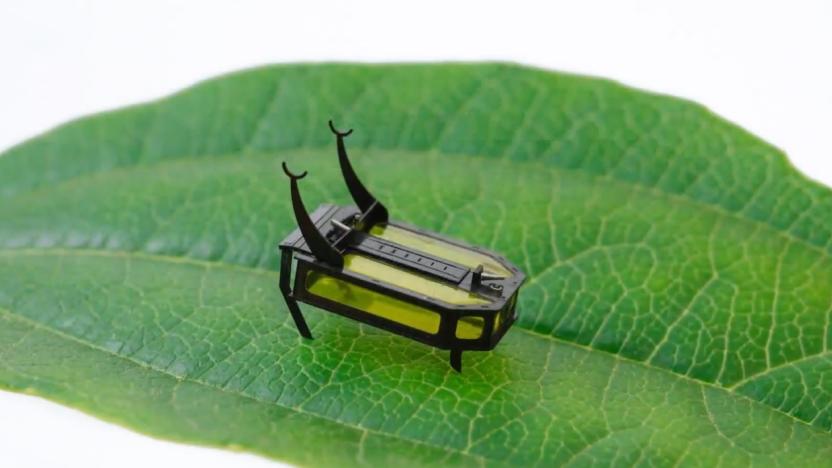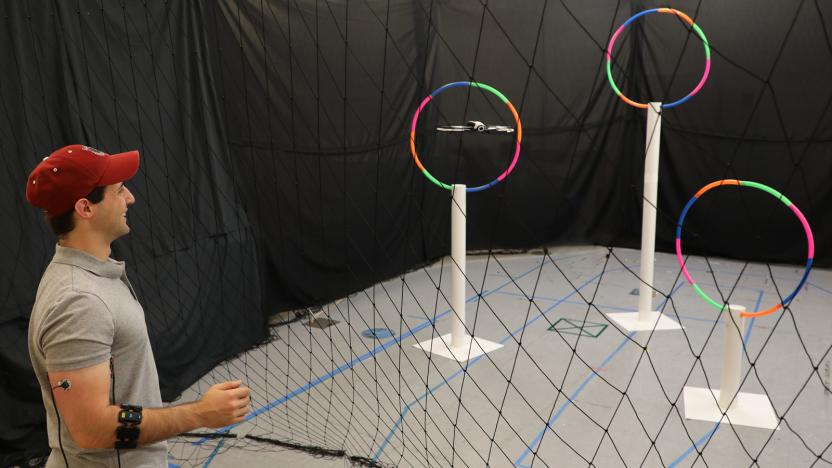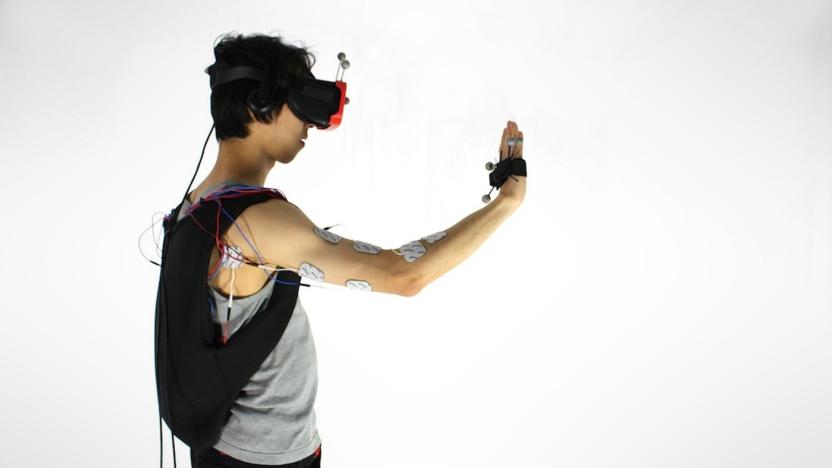muscles
Latest

This tiny robotic beetle travels for two hours without a battery
This tiny, autonomous robotic beetle runs on liquid methanol.

Muscle sensors may let you control a drone by clenching your fist
MIT has developed a system that uses muscle sensors to control robots more intuitively.

Robot bees can crash into walls without taking damage
Tiny robotic fliers aren't exactly durable at present, but they may be tough critters before long. Harvard researchers have developed a RoboBee that uses soft, artificial muscles (really, actuators) to fly without taking damage. The robot can smack into walls, crash-land or even collide with fellow 'bees' without getting hurt. Soft-muscle fliers have existed before, but this is the first with enough power density and control to hover -- that is, it's not just flying wildly.

MIT scientists 'work out' synthetic hydrogels to make them stronger
Your muscles are soft, pliable, and can resist fatigue after thousands of repetitive movements. Researchers at MIT have found a way to make synthetic hydrogels act like muscles by putting them through a vigorous workout. After being mechanically trained in a water bath, the hydrogels became pliant, soft and resistant to breakdown. A paper with the study's findings was published this week in Proceedings of the National Academy of Sciences.

Researchers simulate walls in VR by shocking your muscles
Virtual reality is still a pretty crappy facsimile of The Matrix, but scientists are trying their best to fix that. At the CHI'17 conference in Denver, a team of researchers from the Hasso-Plattner-Institut in Potsdam showed off a haptic system that can simulate walls or heavy objects via electrical muscle stimulation. "We were really interested in trying to explore one of the hardest things to recreate in terms of physical sensation, which is a wall," says co-author Pedro Lopes.

Play video games with your muscles
Sure, you use your muscles during a 12-hour Skyrim marathon and we're sure your phalanges are extremely trim, but that's not the same as using your muscles to play a game. Biomedical company Advancer Technologies has created the USB Biofeedback Game Controller, a device that reads the electromyographic output of unique muscles to move (in the above demo video) Mario through level one of Super Mario Bros. 3. In the demo, this man's bulging right forearm controls the classic A button to jump, his right bicep moves Mario right, up and down, and his left bicep moves him left. Advancer sees applications for the USB Biofeedback Game Controller in treating patients with neuromuscular disease or injury, but we see it as a welcome break from those old-school, non-muscle-stimulating controls you've been using for so long. Don't ask how we know the type of controller you use -- we just know. Advancer has provided instructions to build your own USB Biofeedback Game Controller, so there's really no excuse not to.

Rubbery artificial muscles promise to make robots more lifelike
Some robots may already look pretty lifelike, but it's still quite a different story when they're actually moving, when all the mechanical parts inside make themselves known with some unmistakable, robot-like movements. Some researchers at New Zealand's Auckland Bioengineering Institute now have one possible solution to that problem, however -- a motor with none of the usual moving parts. Instead, the rubbery, Cronenberg-esque contraption relies on some electroactive structures that can stretch by more than 300 percent, and expand and contract when a voltage is applied. While things are obviously still very early, it's conceivable that robots could eventually be built entirely out of these artificial muscles -- or, as lead researcher Dr. Iain Anderson succinctly puts it, "the future is soft." Video after the break.

Athlete Robot runs just a few steps before falling down, does it with style
Since 2007, researchers at Tokyo University's ISI Lab have been working on a prototype of a running robot, which we've seen several of in the past. Athlete Robot (as it is seemingly dubbed) is a little bit different though. While it hasn't outwardly been given the humanoid treatment in any significant way, technologically, it works very much like a human. As you'll see in the video below, early prototypes of the bot which were less 'human' like in design didn't function as well as the newer version, which boasts McKibben artificial muscles and a biologically correct musculoskeletal system. Now, the robot still can't run very far without falling over, but it's impressive to watch its movements nonetheless.

Active Book microchip provides hope for exercising paralyzed limbs
Scientists have been experimenting with muscles and technology to solve both human and robotic mobility issues for years. Now it looks as though a team of researchers from University College London, Freiburg University, and the Tyndall Institute in Cork have made a significant leap forward for paraplegics, thanks to a revolutionary microchip the team has dubbed "Active Book." What's notable about the chip is that it stimulates more muscle groups than existing technology without the need for external connections. This was accomplished via micro-packing and precision laser processing, which allowed tiny electrodes to be cut from platinum foil and rolled into a 3D book shape. These platinum foil "pages" close in around nerve roots, and are micro-welded to a hermetically sealed silicon chip. Once embedded into areas within the spinal canal, the chip can work to stimulate paralyzed muscles, implying patients could even "perform enough movement to carry out controlled exercise such as cycling or rowing." A press release from the Council which sponsored the research says the Active Book will begin trials sometime next year -- we can't wait to see the results.

DARPA-funded prosthetic arm reaches phase three, would-be cyborgs celebrate
Last we heard from Johns Hopkins University's Applied Physics Laboratory, it wanted a neurally-controlled bionic arm by 2009. Needless to say, the school overshot that goal by a tiny bit, and have now been beaten (twice) to the punch. But DARPA sees $34.5 million worth of promise in their third and final prototype, which will enable the nine pound kit (with 22 degrees of freedom and sensory feedback) to begin clinical trials. Rechristened the Modular Prosthetic Limb, it will be grafted onto as many as five real, live persons, the first within the year. Using the targeted muscle reinnervation technique pioneered at the Rehabilitation Institute of Chicago, patients will control these arms directly with their thoughts, and for their sakes and the fate of humanity, hopefully not the other way around. Press release after the break.

New material could make robot muscles better, faster, stronger
There's already been countless advances in the always exciting field of robot muscles, but a team of researchers from the University of Texas have now made what appears to be a considerable leap forward, which they say could allow for "performance characteristics that have not previously been obtained." The key to that is an entirely new material comprised of ribbons of tangled nanotubes, which can expand its width by 220% when a voltage is applied and return to its original shape in just milliseconds when the voltage is removed. What's more, the material is not only "stronger than steel and stiffer than diamond," but it's able to withstand an extreme range of temperatures from -196 °C to 1538 °C, which could allow robots equipped with the muscles to operate with ease in a wide variety of off-world colonies, er, "harsh environments." Head on past the break for a demonstration of the material in its non-robot form.[Image courtesy NASA Jet Propulsion Laboratory]

All the World's a Stage: If looks could kill
All the World's a Stage is a column for inquisitive minds, playing with roles every Sunday evening. The media usually portrays WoW as a "boy's game." That's not to say girls don't play too, of course -- just that the game is basically about qualities such as aggressiveness and violence, and our culture expects males to be interested in that sort of thing. Whether such a designation is true or not, the "masculine equals violent" stereotype is very pervasive, and it is natural for many male players to begin the game with a powerful and intimidating character in mind. The player may imagine that his avatar is warm and kind-hearted inside, but outwardly, his character looks as though he could rip out your throat with a flick of his pinky finger.But there are many men out there who don't like such exaggerated manliness in their characters, just as there are many women who don't want their character to look like a dainty barbie doll. Being a person isn't just about just one gender attribute, after all. Indeed, female characters in WoW can achieve a full range of human attributes in their appearance; they can look friendly and intelligent, yet lightning quick and deadly at the same time. However, the appearance of male characters is often so filled to the brim with "strength and honor" that there's not much room left for any other human quality.

Air-driven robotic legs hop, skip and jump
Though we've certainly seen robotic legs that like to get their jump on, a team of researchers at the University of Tokyo have assembled a new two-legged creature that can actually spring up about 50-centimeters on its own -- and land gracefully. The creation is part of a larger project aimed at creating humanoids with cat-like (or just human-like, really) reflexes that can better assist the elderly when used as caregivers. Moreover, this hopper relies on air-driven artificial muscles rather than electric motors, and while we're not sure it could hang with Ronaldinho, it can boot a fútbol when asked.

Festo's fluidic muscles make us all look weak
Yeah, we've seen some pretty fancy robotic arm work already this year, but Festo is out to show 'em all up with its fluidic muscle-packin' Airic's_arm. This robotic prosthesis sports a "bone structure" which mimics that found on a real live human, and can be moved via the 30 "muscles" built within. Essentially, Festo's approach to movement relies on "an elastomer tube reinforced by aramid fibers, which contract quickly and exert a pulling force when they're filled with a blast of compressed air or liquid." Of course, you'll notice it doesn't offer quite the same range as less bionic alternatives, but this thing's pretty accurate, indeed. Check it out for yourself, the video's right down there.[Via DesignNews]Read - Festo's Airic's_armRead - Video of Airic's_arm in action

Here comes Beefiness Training
From Dorasu, developers of Duke Saraie no Kenkou Walking Navi, comes the very latest in awkward-looking health training programs for the DS. Nobuaki Kakuda's Kaku-chan Type Muscle Train-Navi will use exercise descriptions and animations of the very big and tough-looking karate champion Nobuaki Kakuda to teach users how to bulk up. Users will be able to choose what bulk-related issue they need to work on, with exercise programs based on specific goals, like looking good in a tank top. Then they'll get to watch Nobuaki performing the exercises in a fake living room, sometimes using chairs as props.Stuff like this is precisely why we love reporting on the Nintendo DS. We can't wait to see what the other four games in Dorasu's series are.

Play Snake on your Nokia Series 60 / 80 by flexing your biceps
A Finnish fellow named Arto Holopainen on the Nokia forums has just come up with a way to control your cellphone without touching the phone -- that is, controlling it via Bluetooth-enabled EMG monitoring devices hooked up to your biceps. Holopainen took a Series 60 (or 80) phone, a small battery-operated Bluetooth-enabled two-channel electromyogram device (you know, the one that takes measurements of electrical muscle activity) and the MuscleMonitor application to run on his phone, and then managed to map various muscle activity levels to cellphone functions. Specifically, he's made it possible to play the classic game Snake through muscle flexing to control the various movements in the game. Holopainen elaborates that one could further map the software so that you could even text message by just flexing your muscles -- why one would want to do this, we have no idea, but we're sure that he looks absolutely ridiculous trying to get a workout by playing Snake.







